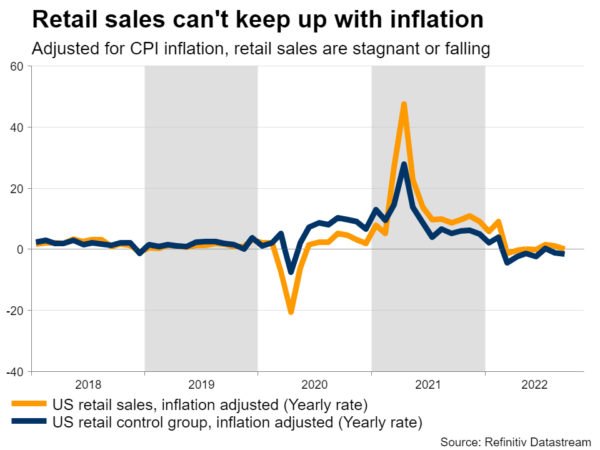Hopes that inflation is finally cooling down led traders to unwind bets that the Fed will raise rates beyond 5%, dealing a heavy blow to the US dollar last week. The next event is the retail sales report this week. It will reveal how demand is holding up, helping investors decide whether the selloff in the dollar was an overreaction or the beginning of a trend reversal.
Fed bets
The latest US inflation data came as a bombshell for markets, causing a drastic rethinking around how quickly and how high the Fed will lift interest rates. With mounting signs that inflation has started to cool, the conclusion was that the Fed will ‘only’ raise rates by half a percentage point next month and the peak will be below 5%.
This shift inflicted severe damage on the dollar, which lost more than 4% against the euro in a single week as US yields came crashing down, eroding its interest rate advantage. Admittedly though, this sharp reaction was probably driven by one-sided positioning. Since ‘long dollar’ was a very crowded trade, huge reversals can happen merely as traders lock in profits.
Most importantly, the story around the Fed hasn’t changed enough to warrant such dramatic moves. While inflation might have peaked, it is still running at almost four times the Fed’s target and there is no telling how quickly it will come down. With China slowly relaxing its zero-covid strategy too, commodity prices could come back to life, boosting inflationary pressures again.
Drawing conclusions from one data point is never a good idea, so it is difficult to say at this stage whether the latest market moves were an overreaction or the beginning of the end for the dollar’s rally. The picture will become clearer on Wednesday, with the latest batch of US retail sales.
Slowing down
In October, retail sales are expected to have risen by 1% after stagnating the previous month, while the retail control group that is used in GDP estimates is projected to clock in at 0.3%, a slight deceleration from September. In yearly terms, both are set to slow dramatically, as much stronger numbers drop out of the 12-month calculation.
Bear in mind that retail sales numbers are not adjusted for inflation. Once we account for inflation running at 7.7%, retail sales are basically stagnant from last year. That’s a worrisome sign, but the counter is that consumption has shifted towards services and away from goods since last year, so focusing on retail sales as a proxy of demand is not wise.
In any case, the dollar will most likely react to any surprises. Prints that surpass expectations would be the best outcome for the currency, as that could revive speculation for Fed rates to exceed 5% in this cycle. In this case, euro/dollar could edge back below 1.0370, and perhaps aim for another test of the 1.0090 region.
On the flipside, a disappointing dataset could reinforce the narrative that the Fed will be more cautious. That could propel euro/dollar even higher, with a move above the 200-day moving average at 1.0428 opening the door towards the 1.0610 zone.
Big picture
All told, the dollar is currently at a crossroads. Most of the elements that fueled this stunning rally seem to be losing their kick, for instance with inflation cooling down but potentially yet to peak in other economies, and big government spending packages off the table now that Congress will likely be divided.

Meanwhile, the outlook for other major currencies has started to improve. A sharp decline in European energy prices paints a brighter picture for the Eurozone economy, nerves around UK politics have calmed for now, and the Bank of Japan seems to be gearing up for policy changes.
Markets don’t move in straight lines and the dollar might still have one ‘last hurrah’ left, especially if the global economy falls into recession. Still, this ferocious rally seems to be on its last legs.














